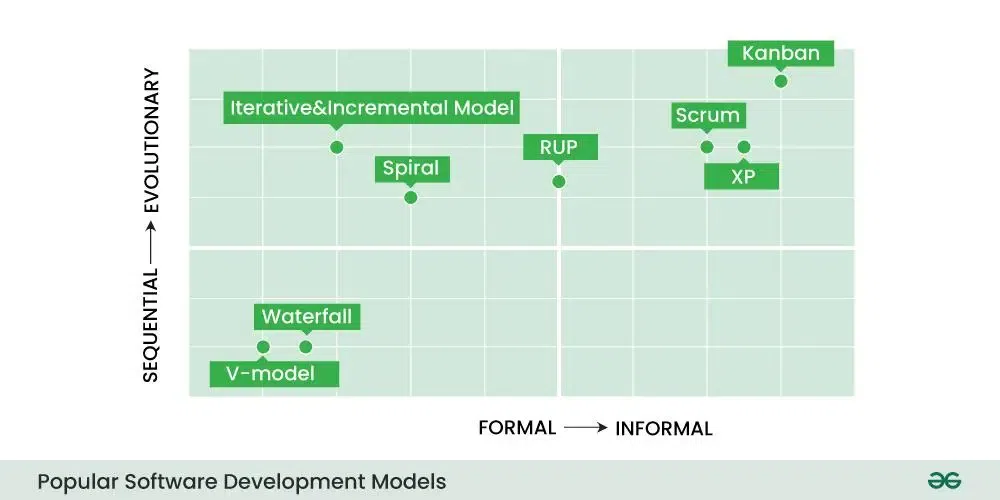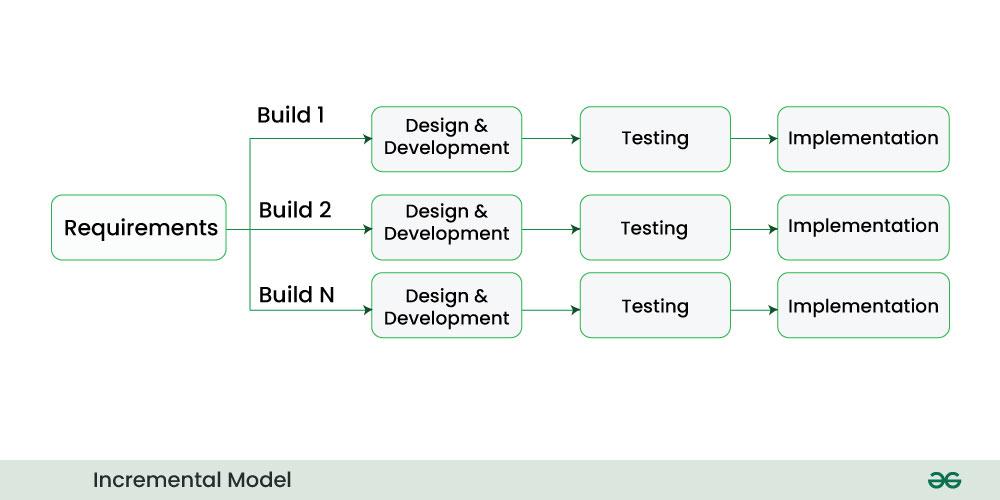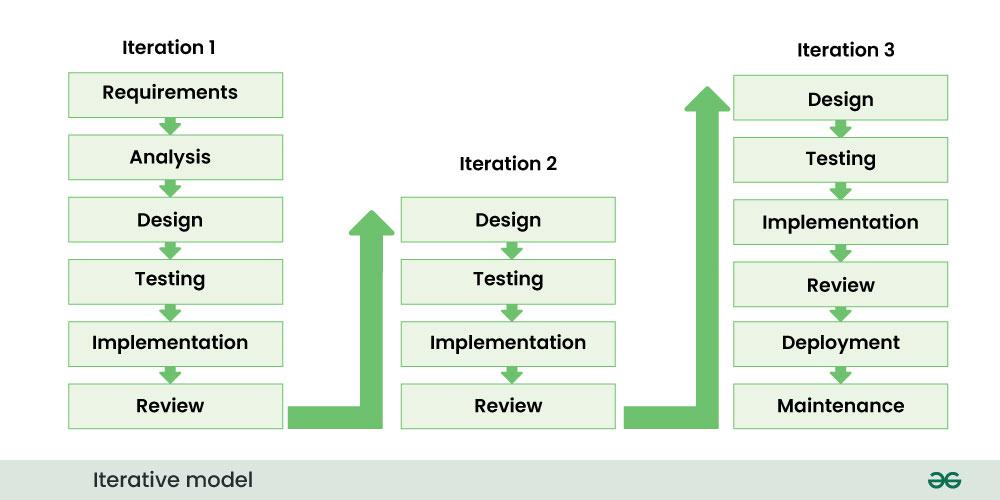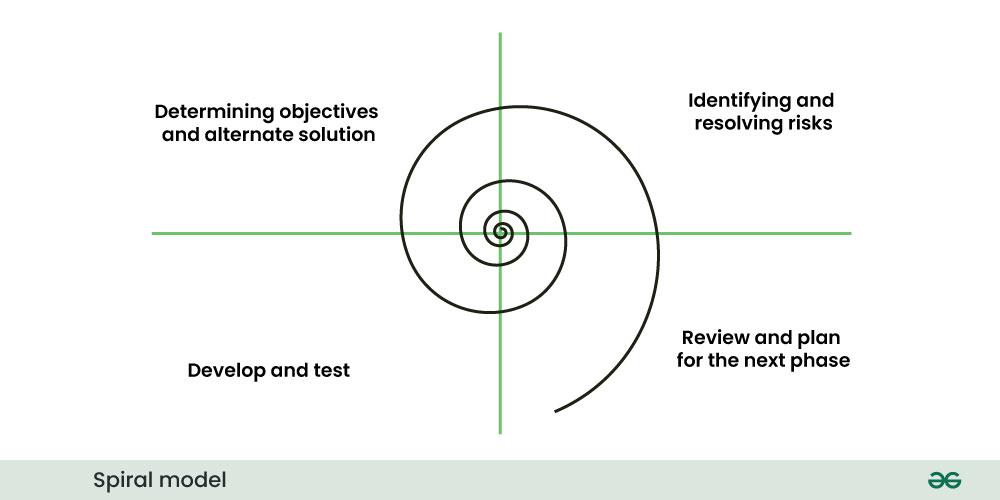Top 8 Software Development Life Cycle (SDLC) Models used in Industry
Last Updated : 23 Apr, 2025
Software development models are various processes or methods that are chosen for project development depending on the objectives and goals of the project. Many development life cycle models have been developed to achieve various essential objectives. Models specify the various steps of the process and the order in which they are executed.
What is Software Modeling?
Software modeling is the process of creating abstract representations of a software system. These models serve as blueprints that guide developers, designers, and stakeholders through the system’s structure, behavior, and functionality.
By using diagrams and various modeling languages, software modeling helps in visualizing and understanding the complex aspects of the software, making it easier to plan, develop, and manage the system.
Top 8 Software Development Models
Choosing the right model is very important for the Development of a Software Product or application. Development and testing processes are carried out based on the model.
Different companies, depending on the software application or product, choose the type of development model whichever is appropriate for their application. But these days 'Agile Methodology' is the most popular in the market.
Let's look at the every model in brief one by one:-
 Popular-Software-Development-Models
Popular-Software-Development-Models1. Agile Model
Agile Development Model is a combination of iterative and incremental models, that is, it is made up of iterative and incremental models.
- In Agile model, focus is given to process adaptability and customer satisfaction.
- In earlier times, iterative waterfall model was used to create software. But in today's time developers have to face many problems. The biggest problem is that in the middle of software development, the customer asks to make changes in the software. It takes a lot of time and money to make these changes. So to overcome all these shortcomings, the agile model was proposed in the 1990s.
The Agile Model was created mainly to make changes in the middle of software development so that the software project can be completed quickly.
 Agile Model
Agile Model- In the agile model, the software product is divided into small incremental parts. In this, the smallest part is developed first and then the larger one.
- And each incremental part is developed over iteration.
- Each iteration is kept small so that it can be easily managed. And it can be completed in two-three weeks. Only one iteration is planned, developed and deployed at a time.
2. Waterfall Model
Waterfall Model is a famous and good version of SDLC(System Development Life Cycle) for software engineering. The waterfall model is a linear and sequential model, which means that a development phase cannot begin until the previous phase is completed. We cannot overlap phases in waterfall model.
Phases of Waterfall model
 Waterfall Model
Waterfall ModelSimilarly waterfall model also works, once one phase of development is completed then we move to the next phase but cannot go back to the previous phase. In the waterfall model, the output of one phase serves as the input for the other phase.
3. V-Model
V-Model is an SDLC model, it is also called Verification and Validation Model. V-Model is widely used in the Software Development Process, and it is considered a disciplined model. In V-Model, the execution of each process is sequential, that is, the new phase starts only after the previous phase ends.
Phases of V-model
 V-Model
V-Model- It is based on the association of testing phase with each development phase that is in V-Model with each development phase, its testing phase is also associated in a V-shape in other words both Software Development and testing activities take place at the same time.
- So in this model, Verification Phase will be on one side, Validation Phase will be on the other side that is both the activities run simultaneously and both of them are connected to each other in V-Shape through Coding Phase, hence it is called V-Model.
- V-Design: In V-Design the left side represents the development activity, the right side represents the testing activity.
4. Incremental Model
In Incremental Model, the Software Development Process is divided into several increments and the same phases are followed in each increment. In simple language, under this model a complex project is developed in many modules or builds.
 Incremental Model
Incremental Model- For example, we collect the customer's requirements, now instead of making the entire software at once, we first take some requirements and based on them create a module or function of the software and deliver it to the customer. Then we take some more requirements and based on them add another module to that software.
- Similarly, modules are added to the software in each increment until the complete system is created. However, the requirements for making a complex project in multiple iterations/parts should be clear.
- If we understand the entire principle of Incremental methodology, then it starts by developing an initial implementation, then user feedback is taken on it, and it is developed through several versions until an accepted system is developed. Important functionalities of the software are developed in the initial iterations.
Each subsequent release of a software module adds functions to the previous release. This process continues until the final software is obtained.
5. RAD Model
RAD Model stands for rapid application development model. The methodology of RAD model is similar to that of incremental or waterfall model. It is used for small projects.
The main objective of RAD model is to reuse code, components, tools, processes in project development.
 RAD Model
RAD Model- If the project is large then it is divided into many small projects and these small projects are planned one by one and completed. In this way, by completing small projects, the large project gets ready quickly.
- In RAD model, the project is completed within the given time and all the requirements are collected before starting the project. It is very fast and there are very less errors in it.
6. Iterative Model
In Iterative Model we start developing the software with some requirements and when it is developed, it is reviewed. If there are requirements for changes in it, then we develop a new version of the software based on those requirements. This process repeats itself many times until we get our final product.
Through this diagram you can understand the Interactive model.
 Iterative Model
Iterative Model- So, in Iterative model a software is developed by following several iterations. Iteration means that we are repeating the Development Process again and again. For example, we develop the first version of the software following the SDLC process with some software requirements.
- After the first version is developed, if there is a need to change the software , then a new version is developed with the second iteration. Now again we will see if the new version is enough, if not then we will make changes in it with the third iteration. The iteration will be repeated until the complete software is ready.
- The basic concept of Iterative model is that the software should be developed through repeated cycles or what we also call iteration and only a small part of it should be developed at a time. This model was developed to overcome the drawbacks of the classical waterfall model.
7. Spiral Model
Spiral Model is a software development process model. This model has characteristics of both iterative and waterfall models. This model is used in projects which are large and complex. This model was named spiral because if we look at its figure, it looks like a spiral, in which a long curved line starts from the center point and makes many loops around it. The number of loops in the spiral is not decided in advance but it depends on the size of the project and the changing requirements of the user. We also call each loop of the spiral a phase of the software development process.
 Spiral Model
Spiral ModelIn Spiral Model the entire process of software development is described in four phases which are repeated until the project is completed.
A software project goes through these loops again and again in iterations. After each iteration a more and more complete version of the software is developed. The most special thing about this model is that risks are identified in each phase and they are resolved through prototyping. This feature is also called Risk Handling.
Since it also includes the approaches of other SDLC models, it is also called Meta Model. It was first developed by Barry Boehm in 1986.
8. Prototype model
Prototype Model is an activity in which prototypes of software applications are created. First a prototype is created and then the final product is manufactured based on that prototype.
One problem in this model is that if the end users are not satisfied with the prototype model, then a new prototype model is created again, due to which this model consumes a lot of money and time.
 Prototype Model
Prototype Model- The prototype model was developed to overcome the shortcomings of the waterfall model.
- This model is created when we do not know the requirements well.
- The specialty of this model is that this model can be used with other models as well as alone.
Why companies are shifting toward agile Software Development models?
In earlier times, iterative waterfall model was used to create software. But in today's time developers have to face many problems. The biggest problem is that in the middle of software development, the customer asks to make changes in the software. It takes a lot of time and money to make these changes. The agile model was created mainly to make changes in the middle of Software Development so that the software project can be completed quickly.
Agile focuses on customer-centric approach that constantly take feedback from customer and make changes in the middle of software developer according to their needs and expectation. Agile Methodologies like scrum adopt iterative and incremental approach this accelerate the time-to-market for new features and product.
Conclusion
Choosing the right software development model is important for the Success of a Project. Each model offers unique advantages and is suitable for Different Types of Projects. Agile Methodologies, due to their flexibility and customer-centric approach, are increasingly popular in the industry. By adopting Agile, companies can accelerate time-to-market and better adapt to changing requirements, leading to higher customer satisfaction and Successful Project Outcomes.
Similar Reads
Software Development | Introduction, SDLC, Roadmap, Courses Software development is defined as the process of designing, creating, testing, and maintaining computer programs and applications. This software development roadmap is best suited for students as well as software development enthusiasts. It covers all the terminologies and details that will guide a
10 min read
What is Software Development? Software Development is defined as the process of designing, creating, testing, and maintaining computer programs and applications. Software development plays an important role in our daily lives. It empowers smartphone apps and supports businesses worldwide. According to the U.S. BureÂau of Labor S
10 min read
Software Development Life Cycle (SDLC) Software development life cycle (SDLC) is a structured process that is used to design, develop, and test good-quality software. SDLC, or software development life cycle, is a methodology that defines the entire procedure of software development step-by-step. The goal of the SDLC life cycle model is
11 min read
Software Development Models - SDLC Models SDLC Models or Software Development Life Cycle (SDLC) models are frameworks that guide the development process of software applications from initiation to deployment. Various SDLC models in software engineering exist, each with its approach to the phases of development. SDLC Models - Software Develo
15+ min read
Top Software Development Topics to prepare for Interview Software development refers to a set of computer science activities dedicated to the process of creating, designing, deploying, and supporting software. Table of Content Programming languageData structuresAlgorithmsSystem DesignCodingObject-oriented designDatabasesDistributed computingOperating syst
9 min read
Software Developer (SDE) Interview/Placement Preparation Guide Software Developer (SDE) Interview/Placement Preparation requires a well-rounded approach, covering technical and non-technical aspects. Embarking on a journey to secure a software developer position involves meticulous preparation, encompassing technical and non-technical aspects. Here's a comprehe
9 min read
Software Development Evolution & Trends
Evolution of Software Development | History, Phases and Future TrendsSoftware development, the process of creating computer programs to perform various tasks, has evolved significantly since its inception. This evolution has been driven by technological advancements, changing needs, and the growing complexity of the digital world. Let's explore the key stages in the
8 min read
10 Reasons Why Software Development is Important ?Everyday we hear about Software Development in different aspects of the technological world. But have you ever wondered why Software Development is so popular ? It must be very important, right ? So in this post, we have broken down into basics to understand the fundamental reasons why Software Deve
9 min read
Top 12 Software Development Languages [2024]Software Development Languages are programming languages that are used in the development of software. Selecting the appropriate programming language is a critical choice. The year 2024 is no different, for amidst the changing variety of programming languages, it becomes important to stay aware and
10 min read
Latest Software Development Technology/Trends to look out for [2024]The digital world has undergone a profound transformation, changing the way we live, work, and connect with our environment. This transformation is driven by innovative software development technologies that continue to evolve, reshaping the digital landscape. In this article, we will explore some o
6 min read
Most Popular Software Development Companies in India 2023-2024Software development refers to the process of creating software applications which is the most important part of information technology. There is a need for software development in the IT industry as it allows businesses to build custom applications that can automate and improve the efficiency of th
8 min read
Software Development Life Cycle
Software Development ProcessThe software development process is the approach to developing, and delivering software applications. This process might include improving design and product management by splitting the work into smaller steps or processes.Software is a set of programs having specific functions that are designed to
10 min read
Software paradigm and Software Development Life Cycle (SDLC)Software paradigm refers to method and steps, which are taken while designing the software. Programming paradigm is a subset of software design paradigm which is further a subset of software development paradigm. Software is considered to be a collection of executable programming code, associated li
9 min read
Top 5 SDLC(Software Development Life Cycle ) MethodologiesWe all know the importance of successful execution lies within certain procedures to provide efficient delivery. It doesn't matter if you're the stakeholder, a businessperson, a team lead, or an employee. When we talk in the context of software development, SDLC (Software Development Life Cycle) aim
7 min read
Bug Life Cycle in Software DevelopmentAs we know during the development of any software product the development teams follow the Software Development Life Cycle (SDLC) processes. But the development process is not so easy and always runs smoothly. During the development process when a product is being developed different types of defect
9 min read
Software Development Process Step by Step Guide | Requirement, Plan, Design, Develop & DeploySoftware development is a complex and multifaceted process that transforms a concept or idea into a functional, reliable software application. To ensure the successful creation of software, developers follow a structured process that consists of several key steps. In this blog, we will explore the f
6 min read
Role of Verification and Validation (V&V) in SDLCVerification and Validation (V&V) play a crucial role in the Software Development Life Cycle (SDLC) by ensuring that software products meet their requirements and perform as expected. Verification involves checking the software at each development stage to confirm it aligns with specifications,
5 min read
Software Quality - Software EngineeringTraditionally, a high-quality product is outlined in terms of its fitness of purpose. That is, a high-quality product will specifically be what the users need to try. For code products, the fitness of purpose is typically taken in terms of satisfaction of the wants arranged down within the SRS docum
5 min read
Software Testing Life Cycle (STLC)The Software Testing Life Cycle (STLC) is a process that verifies whether the Software Quality meets the expectations or not. STLC is an important process that provides a simple approach to testing through the step-by-step process, which we are discussing here. Software Testing Life Cycle (STLC) is
7 min read
Software Development Models & Methodologies
What is SDLC(Software Development Life Cycle) and its phasesThe Software Development Life Cycle (SDLC) is a process used by software development organizations to plan, design, develop, test, deploy, and maintain software applications. SDLC(Software Development Life Cycle)SDLC (Software Development Life Cycle) is used in Every Software Development Company bec
3 min read
5 Most Commonly used Software Development MethodologiesSoftware development is the process of creating, testing, and maintaining software products and services that meet user, customer, or stakeholder expectations. Software development methodologies are frameworks or models that guide the software development process and define the roles, responsibiliti
7 min read
Top 8 Software Development Life Cycle (SDLC) Models used in IndustrySoftware development models are various processes or methods that are chosen for project development depending on the objectives and goals of the project. Many development life cycle models have been developed to achieve various essential objectives. Models specify the various steps of the process a
9 min read
Waterfall Model - Software EngineeringThe Waterfall Model is a Traditional Software Development Methodology. It was first introduced by Winston W. Royce in 1970. It is a linear and sequential approach to software development that consists of several phases. This classical waterfall model is simple and idealistic. It is important because
13 min read
What is Spiral Model in Software Engineering?The Spiral Model is one of the most important SDLC model. The Spiral Model is a combination of the waterfall model and the iterative model. It provides support for Risk Handling. The Spiral Model was first proposed by Barry Boehm. This article focuses on discussing the Spiral Model in detail.Table o
9 min read
Advantages and Disadvantages of using Spiral ModelThe Spiral Model is a software development approach that involves iterative development with risk management. It is appropriate for large, complex, and high-risk projects, because it provides continuous improvement through multiple phases or spirals. Planning, prototyping, and feedback are the core
3 min read
SDLC V-Model - Software EngineeringThe SDLC V-Model is a Types of Software Development Life Cycle (SDLC), which is used in Software Development process. In V-Model is the extension of the Traditional Software Development Model.It is creating a Structure like the "V" which includes the different phases which we are discussing here in
10 min read
Prototyping Model - Software EngineeringPrototyping Model is a way of developing software where an early version, or prototype, of the product is created and shared with users for feedback. The Prototyping Model concept is described below: Table of ContentWhat is Prototyping Model?Phases of Prototyping ModelTypes of Prototyping ModelsAdva
7 min read
Rapid Application Development Model (RAD) - Software EngineeringThe RAD model or Rapid Application Development model is a type of software development methodology that emphasizes quick and iterative release cycles, primarily focusing on delivering working software in shorter timelines. Unlike traditional models such as the Waterfall model, RAD is designed to be
9 min read
Agile Software Development - Software EngineeringAgile Software Development is a Software Development Methodology that values flexibility, collaboration, and customer satisfaction. It is based on the Agile Manifesto, a set of principles for software development that prioritize individuals and interactions, working software, customer collaboration,
15+ min read
Waterfall vs Agile Development | Software Development Life Cycle ModelsWaterfall and Agile are the two most used Software Development Development Life Cycle (SDLC) Models. Hence it is very common to face a dilemma - waterfall model or agile model, which one to choose and why. To shower light upon this waterfall vs agile model, let us see a detailed discussion of their
2 min read
Agile Software Development
Agile Software Development Methodology | Framework, Principles, and BenefitsAgile Software Development Methodology in software development is an efficient methodology that helps teams produce high-quality software quickly and with flexibility. Agile is not just a methodology; it's a mindset. At its core, Agile values individuals and interactions, working solutions, and cust
8 min read
Agile Development Models - Software EngineeringIn earlier days, the Iterative Waterfall Model was very popular for completing a project. But nowadays, developers face various problems while using it to develop software. The main difficulties included handling customer change requests during project development and the high cost and time required
11 min read
Agile Methodology Advantages and DisadvantagesAgile Software Development Methodology is a process of software development similar to other software development methodologies like waterfall models, V-models, iterative models, etc. Agile methodology follows the iterative as well as incremental approach that emphasizes the importance of delivering
4 min read
Agile SDLC (Software Development Life Cycle)Software Development Life Cycle (SDLC) is a process of maintaining or building software applications/services/systems. Generally, it includes various levels, from initial development plan and analysis to post-development software testing and evaluation. It also consists of the models and methodologi
8 min read
User Stories in Agile Software DevelopmentUser stories are a key component of agile software development. They are short, simple descriptions of a feature or functionality from the perspective of a user. User stories are used to capture requirements in an agile project and help the development team understand the needs and expectations of t
7 min read
Crystal Method in Agile Development/FrameworkCrystal methods are flexible approaches used in Agile software development to manage projects effectively. They adapt to the needs of the team and the project, promoting collaboration, communication, and adaptability for successful outcomes. Table of Content What is Crystal methods in Agile Developm
8 min read
Agile Software TestingAgile testing helps improve software quality by breaking down complex testing into smaller parts which are more manageable. It allows teams to automate tests more frequently, so they can catch issues early and fix them quickly. This approach leads to faster, more reliable software delivery.Here we a
14 min read
Agile Software Process and its PrinciplesAn Agile software process is designed to handle the unpredictability inherent in most software projects. It recognizes that requirements and customer priorities can change rapidly, and it is difficult to predict the necessary design before construction begins. Agile processes integrate design and co
4 min read
What are the 4 Agile Values?The Agile Manifesto is a concise statement of the four core ideals and twelve guiding principles of agile software development. It was published in February 2001 by 17 software development professionals who saw a growing need for an alternative to cumbersome, documentation-driven software developmen
5 min read
What is Scrum in Software Development?Scrum is a popular framework that is used whenever we want to develop complex products, Ken Schwaber and Jeff Sutherland are known as the people who developed Scrum. Scrum is a type of Agile framework. Table of Content What is a scrum in software development?Silent features of Scrum Advantage of Scr
3 min read
Lean Software Development (LSD)Lean Software Development (LSD) is an agile framework used to streamline and optimize the software development process. It may also be referred to as the Minimum Viable Product (MVP) strategy as these ways of thinking are very similar since both intend to speed up development by focusing on new deli
7 min read